20170214--PYTHON介绍+(列表,字典,元组)
2017-02-14 00:00
351 查看
简单的脚本用shell脚本比较方便
当shell搞不定时,我们使用python
python跨平台语言,现在的系统都支持
PYTHON :一种强类型动态脚本编程语言,不需要编译
openstack---用python写的
在linux中如果卸载python,系统直接崩溃
python.org //pyhon官网
python 2与python 3 不兼容
系统中可同时存在多个python版本,可以自由使用任意版本
运行方式
1.在python环境里 python
2.指定解释器
3.在脚本里面指定解释器,再使用./执行
/usr/bin/env python //env 显示环境。这一句可以不用指定python的绝对路径
encoding:utf8
coding:utf8
python lib/module/package: //python的学习内容,就是学模块的使用
4.python中用sys.path 模块可以查看python默认导入包的路径,我们可以用sys.path.append("路径")增加路径
语法:
1.变量直接赋值即可使用
2.字符串用单引号或双引号引起来
3.if 语句 在shell,awk,python中的使用
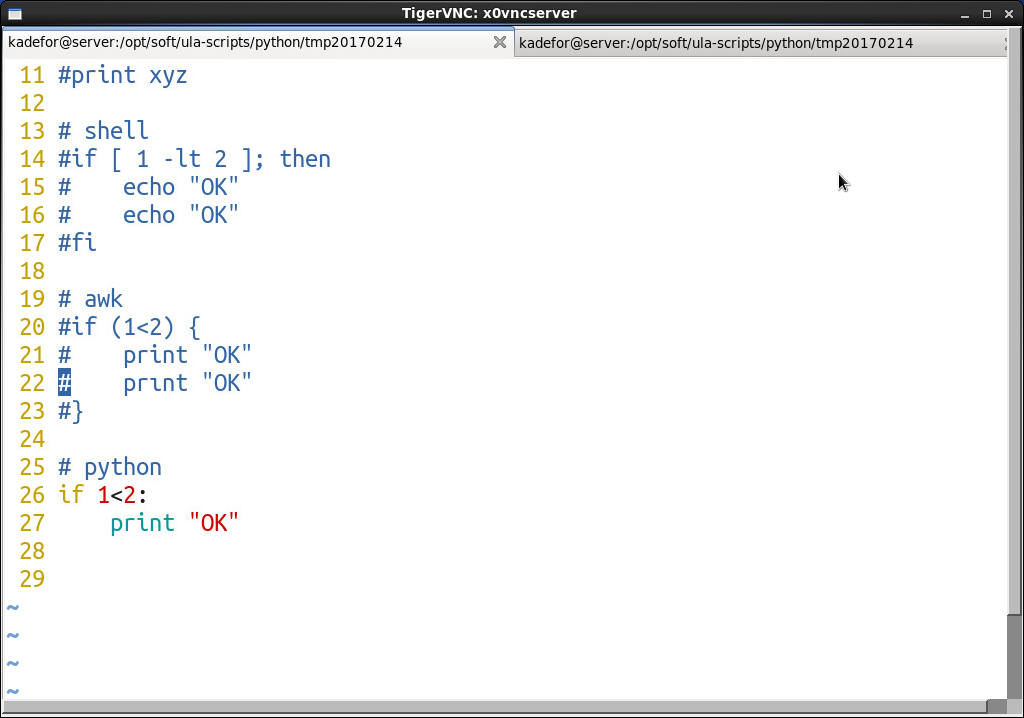
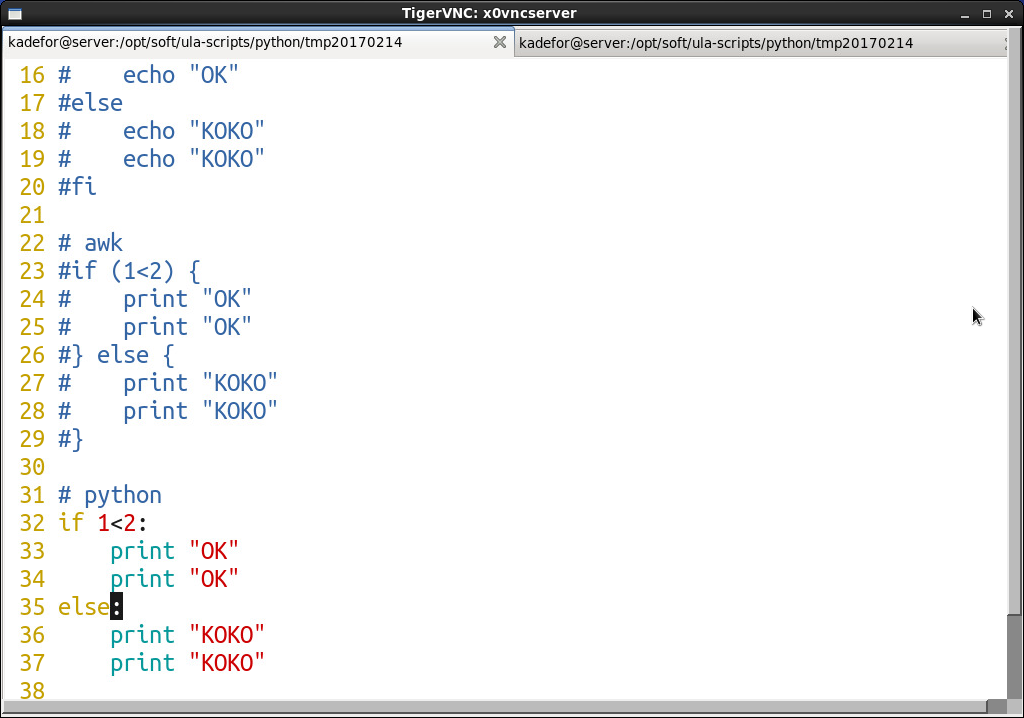
python的if 后面跟真假,if后面可以跟任何东西
python里的任何东西都是对象(object),值为0为空的都是假,值非0都是真的
True|False 布尔值
4.依靠缩进来区分代码块,指标符和空格最好不要混用
5.while |for 循环
python中的以下序列都可以遍历
1>string "uplooking"
2>list [11,22,33,44] //列表可以修改
3>tuple (11,22,33,44,55) //元组不可以修改
4>dict {"uid":500,"gid":600} //key:value 键值对
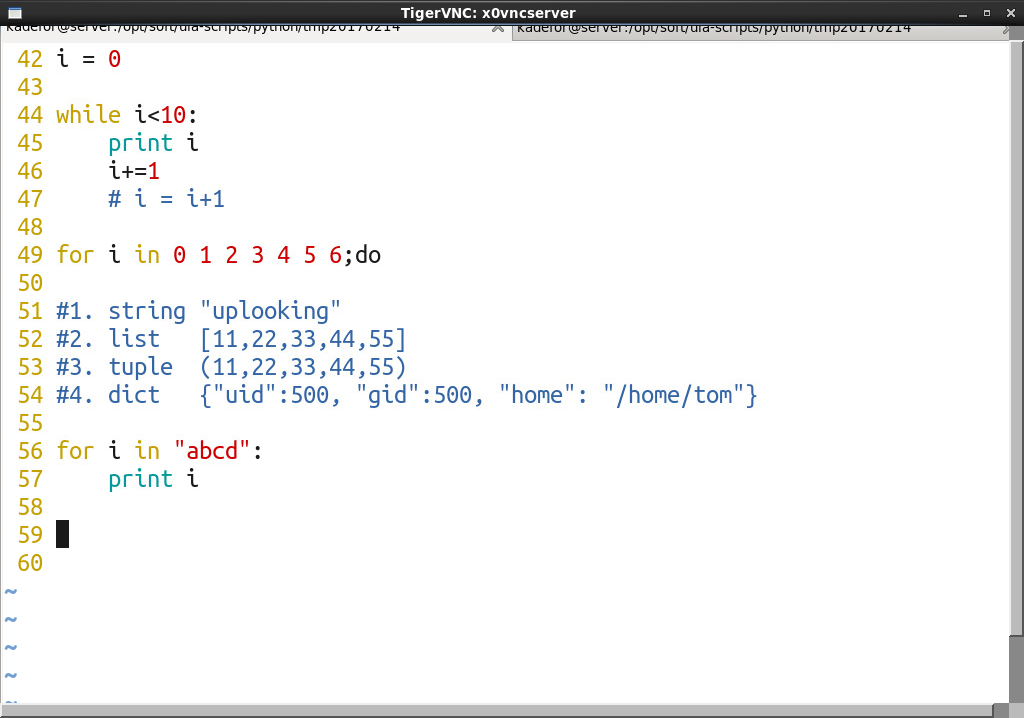
6.函数的定义
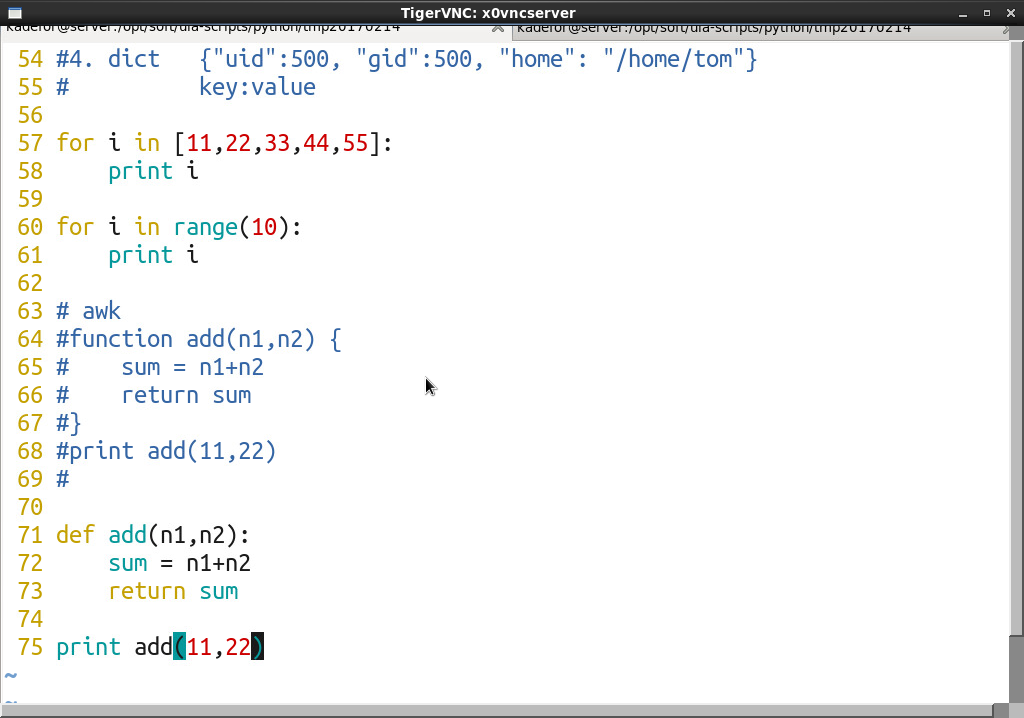
eg: random 函数 //函数的名字尽量不要和模块的名字相同,否则会出现很多不必要
--------------------------------------------------------------------------------------------------------
pydoc random //查看函数的模块文档 ,类似于shell中的man
python里的一切都是对象,一切对象都有属性和方法
dir(对象) //列出对象的属性和方法(方法即定义的函数)
id(对象) //查看对象在内存中的位置
help(对象) //查看对象怎样使用
python中的pass什么都不做,只是用来占位的
trip //去掉两端的空格
ltrip //去掉开头的空格
rtrip //去掉结尾的空格
count //统计字符数
字符串需要用引号引起来,单双都可以,但是不能嵌套,我们可以用三引号,三引号里可以自由使用单双引号,三引号里面可以包含多行字符。
python中的列表:list 把多个元素组合在一起形成列表
>>> dir(os)
>>> dir(os.path) //方法中还有方法
元组:tuple //只读
list(t) ---将元组改变为列表
tuple(l) ---将列表改变为元组 //这两个函数为内部函数
dir(__builtin__) //查看所有的内部
当元组中只有一个对象的时候,我们怎么来定义我们的元组
fromkeys
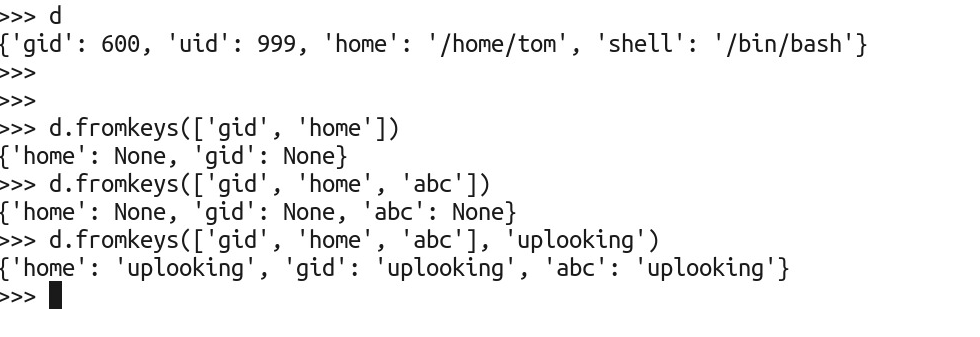
引用拷贝 ---列表是引用拷贝
值拷贝---元组和字符串都是硬链接
切片拷贝

generator 生成器,用来遍历元素
字典 键值对,成对出现,为无序的
键必须要是可hash 的(即不可变的),值可以为任意的类型
字典可以遍历
iteritms
iterkeys
itervalues //迭代的方式,性能会好些
keys //显示建
e.update(tom) //合并两个字典
>>> e["shell"] = "/sbin/nologin"
>>> e
{'shell': '/sbin/nologin', 'gid': 600, 'uid': 500}
>>>
>>> "uid" in e
True
如何得到一个字典:
dict()内部函数
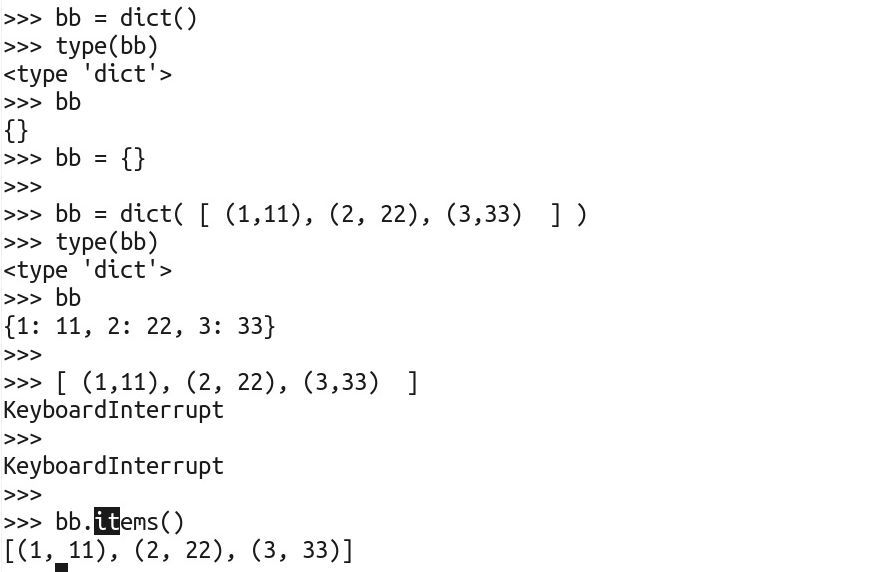

字典和列表的合并
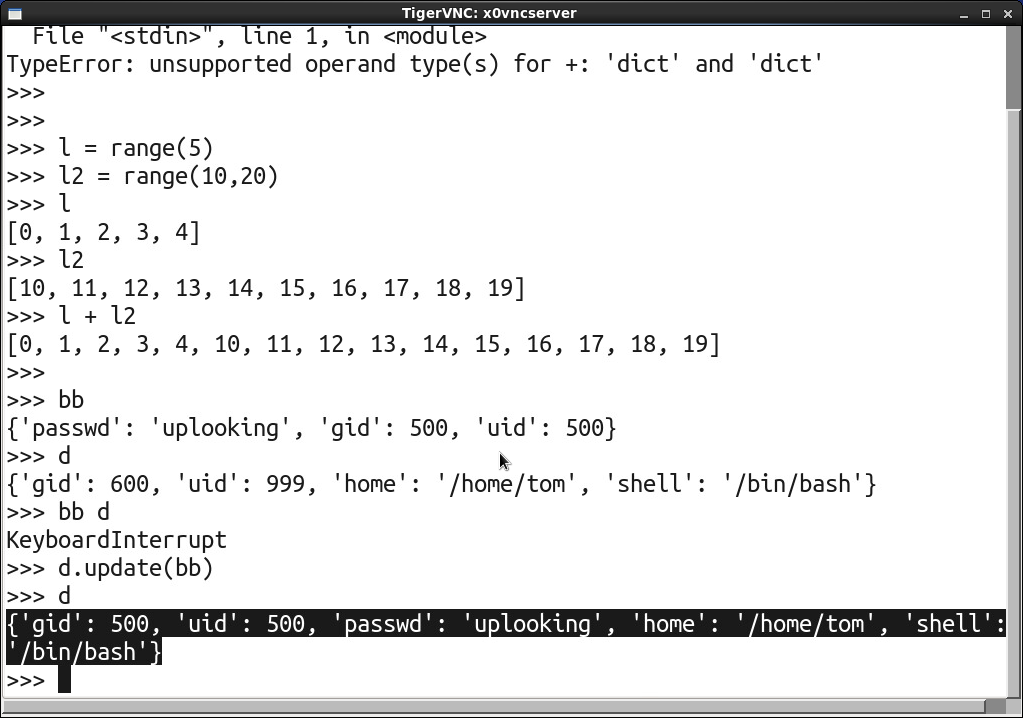
当shell搞不定时,我们使用python
python跨平台语言,现在的系统都支持
PYTHON :一种强类型动态脚本编程语言,不需要编译
openstack---用python写的
在linux中如果卸载python,系统直接崩溃
python.org //pyhon官网
python 2与python 3 不兼容
系统中可同时存在多个python版本,可以自由使用任意版本
运行方式
1.在python环境里 python
2.指定解释器
3.在脚本里面指定解释器,再使用./执行
/usr/bin/env python //env 显示环境。这一句可以不用指定python的绝对路径
encoding:utf8
coding:utf8
python lib/module/package: //python的学习内容,就是学模块的使用
4.python中用sys.path 模块可以查看python默认导入包的路径,我们可以用sys.path.append("路径")增加路径
>>> sys.path ['', '/usr/lib/python2.6/site-packages/pip-9.0.1-py2.6.egg', '/usr/lib/python2.6/site-packages/xpinyin-0.5.4-py2.6.egg', '/usr/lib64/python26.zip', '/usr/lib64/python2.6', '/usr/lib64/python2.6/plat-linux2', '/usr/lib64/python2.6/lib-tk', '/usr/lib64/python2.6/lib-old', '/usr/lib64/python2.6/lib-dynload', '/usr/lib64/python2.6/site-packages', '/usr/lib64/python2.6/site-packages/gst-0.10', '/usr/lib64/python2.6/site-packages/gtk-2.0', '/usr/lib64/python2.6/site-packages/webkit-1.0', '/usr/lib/python2.6/site-packages', '/usr/lib/python2.6/site-packages/setuptools-0.6c11-py2.6.egg-info'] >>>
语法:
1.变量直接赋值即可使用
2.字符串用单引号或双引号引起来
3.if 语句 在shell,awk,python中的使用


python的if 后面跟真假,if后面可以跟任何东西
python里的任何东西都是对象(object),值为0为空的都是假,值非0都是真的
True|False 布尔值
4.依靠缩进来区分代码块,指标符和空格最好不要混用
5.while |for 循环
python中的以下序列都可以遍历
1>string "uplooking"
2>list [11,22,33,44] //列表可以修改
3>tuple (11,22,33,44,55) //元组不可以修改
4>dict {"uid":500,"gid":600} //key:value 键值对

6.函数的定义

eg: random 函数 //函数的名字尽量不要和模块的名字相同,否则会出现很多不必要
1 #!/usr/bin/python2.7
2 #coding:utf8
3 #用python写一个猜数字的游戏
4 #
5 import random
6 ran=random.random(0.99)
7
8 #for i in range(5) #让游戏只有5次机会
9
10 #i=0
11 #while i<5:
12 #i = i+1
13
14 #while 1=1: /while 1:/ while True:
15
16 while 1:
17 num=int(raw_input("请输入一个数字:"))
18 if num == ran :
19 print "you are clever"
20 break #跳出循环,exit()跳出整个python程序
21
22 elif num < ran :
23 print "your number is small!"
24 else num > ran :
25 print "your number is big!"
26 print "游戏结束!"
~--------------------------------------------------------------------------------------------------------
pydoc random //查看函数的模块文档 ,类似于shell中的man
python里的一切都是对象,一切对象都有属性和方法
dir(对象) //列出对象的属性和方法(方法即定义的函数)
id(对象) //查看对象在内存中的位置
help(对象) //查看对象怎样使用
>>> abcd = "www.baidu.com"
>>> a = abcd
>>> dir(a)
['__add__', '__class__', '__contains__', '__delattr__', '__doc__', '__eq__', '__format__', '__ge__', '__getattribute__', '__getitem__', '__getnewargs__', '__getslice__', '__gt__', '__hash__', '__init__', '__le__', '__len__', '__lt__', '__mod__', '__mul__', '__ne__', '__new__', '__reduce__', '__reduce_ex__', '__repr__', '__rmod__', '__rmul__', '__setattr__', '__sizeof__', '__str__', '__subclasshook__', '_formatter_field_name_split', '_formatter_parser', 'capitalize', 'center', 'count', 'decode', 'encode', 'endswith', 'expandtabs', 'find', 'format', 'index', 'isalnum', 'isalpha', 'isdigit', 'islower', 'isspace', 'istitle', 'isupper', 'join', 'ljust', 'lower', 'lstrip', 'partition', 'replace', 'rfind', 'rindex', 'rjust', 'rpartition', 'rsplit', 'rstrip', 'split', 'splitlines', 'startswith', 'strip', 'swapcase', 'title', 'translate', 'upper', 'zfill']
>>> help(a.title) //可以查看如何使用a.title方法
>>> a.lower().upper().title()
'Www.Baidu.Com'
>>> a.lower().upper().title()
'Www.Baidu.Com'
>>> a.replace("com","xxx")
'www.baidu.xxx'
>>> a.replace("com","xxx",1)
'www.baidu.xxx'
>>> a.replace("com","xxx",2)
'www.baidu.xxx'
>>>
>>> a.startswith("www") //以什么开头
True
>>> a.startswith("www3")
False
>>> a.endswith("www3") //以什么结尾
False
>>> a.endswith("com")
True
>>>
>>> a.split(".")
['www', 'baidu', 'com']
>>>
>>> a.replace(".","-").split("-")
['www', 'baidu', 'com']
>>>
>>> a[:2]
'ww'
>>> a[5:]
'aidu.com'
>>> a[:4]
'www.'
>>> a[:4]+"B"+a[5:]
'www.Baidu.com'
>>>
>>> print "%sB%s" % (a[:4],a[5:])
www.Baidu.compython中的pass什么都不做,只是用来占位的
trip //去掉两端的空格
ltrip //去掉开头的空格
rtrip //去掉结尾的空格
count //统计字符数
字符串需要用引号引起来,单双都可以,但是不能嵌套,我们可以用三引号,三引号里可以自由使用单双引号,三引号里面可以包含多行字符。
python中的列表:list 把多个元素组合在一起形成列表
>>> l = [11,22,33,44]
>>> l[0]
11
>>> l[2]
33
>>> l[-1]
44
>>> del l[-1]
>>> l
[11, 22, 33]
>>>
>>> print len(l)
3
>>> l.insert(2,"abc")
>>> l
[11, 22, 'abc', 33]
>>> l.insert(len(l)-1,"kkk")
>>> l
[11, 22, 'xyz', 'abc', 'kkk', 33]
>>> l.remove("abc")
>>> l
[11, 22, 'xyz', 'kkk', 33]
>>>
>>> l.pop() //删掉最后一个元素
33
>>> l
[11, 22, 'xyz', 'kkk']
>>> l.pop(2) //删掉索引为2的元素
'xyz'
>>> l
[11, 22, 'kkk']
>>> bb = [77,88,99,55]
>>> l.append(bb)
>>> l
[11, 22, 'kkk', [77, 88, 99, 55]]
>>> l[-1][2]
99
>>> l
>>> l.remove(bb)
>>> l
[11, 22, 'kkk']
>>>
>>> l.extend(bb)
>>> l
[11, 22, 'kkk', [77, 88, 99, 55], 77, 88, 99, 55]
>>>>>> dir(os)
>>> dir(os.path) //方法中还有方法
元组:tuple //只读
>>> t = (11,22,33,44) >>> dir(t) ['__add__', '__class__', '__contains__', '__delattr__', '__doc__', '__eq__', '__format__', '__ge__', '__getattribute__', '__getitem__', '__getnewargs__', '__getslice__', '__gt__', '__hash__', '__init__', '__iter__', '__le__', '__len__', '__lt__', '__mul__', '__ne__', '__new__', '__reduce__', '__reduce_ex__', '__repr__', '__rmul__', '__setattr__', '__sizeof__', '__str__', '__subclasshook__', 'count', 'index'] >>> //元组只有两种方法
list(t) ---将元组改变为列表
tuple(l) ---将列表改变为元组 //这两个函数为内部函数
dir(__builtin__) //查看所有的内部
当元组中只有一个对象的时候,我们怎么来定义我们的元组
>>> cc = (11) >>> type(cc) <type 'int'> >>> cc = (11,) >>> type(cc) <type 'tuple'> >>>
fromkeys

引用拷贝 ---列表是引用拷贝
>>> a = [1,2,3,4,5,6,7] >>> b = a >>> a [1, 2, 3, 4, 5, 6, 7] >>> b [1, 2, 3, 4, 5, 6, 7] >>> a.pop(0) 1 >>> a [2, 3, 4, 5, 6, 7] >>> b [2, 3, 4, 5, 6, 7] >>>
值拷贝---元组和字符串都是硬链接
>>> c = "123" >>> d = c >>> c '123' >>> d '123' >>> c = "abc" >>> c 'abc' >>> d '123' >>>
切片拷贝
>>> a [2, 3, 4, 5, 6, 7] >>> b [2, 3, 4, 5, 6, 7] >>> id(a) 140381409723240 >>> id(b) 140381409723240 >>> b = a[:] //用切片拷贝就会是值拷贝 >>> id(a) 140381409723240 >>> id(b) 140381409562208 >>>
>>> l = [i for i in a if i>3] >>> l [4, 5, 6, 7] >>> l = [i*10 for i in a ] >>> l [20, 30, 40, 50, 60, 70] >>> a [2, 3, 4, 5, 6, 7] >>> l = [i*10 for i in a if i>2 and i<6] >>> l [30, 40, 50] >>>

generator 生成器,用来遍历元素
>>> l = (i*10 for i in a if i>2 and i<6) >>> l <generator object <genexpr> at 0x7fad180e2730> >>> for i in l: ... print i ... 30 40 50
字典 键值对,成对出现,为无序的
键必须要是可hash 的(即不可变的),值可以为任意的类型
字典可以遍历
>>> tom = {"uid":500,"gid":600,"home":"/home/kate"}
>>> tom
{'home': '/home/kate', 'gid': 600, 'uid': 500}
>>> for i in tom:
... print i
...
home
gid
uid
>>>
>>> for i in tom:
... print i ," => ", tom[i]
...
home => /home/kate
gid => 600
uid => 500
>>>>>> e = tom.copy()
>>> id(tom)
32176912
>>> id(e)
32132272
>>> e
{'home': '/home/kate', 'gid': 600, 'uid': 500}
>>>>>> e.items()
[('home', '/home/kate'), ('gid', 600), ('uid', 500)]
>>> a,b = 11,22
>>> a,b = (11,22)
>>> a
11
>>> b
22
>>> for k,v in e.items():
... print k,v
...
home /home/kate
gid 600
uid 500iteritms
iterkeys
itervalues //迭代的方式,性能会好些
keys //显示建
>>> e.popitem() //删除键值对
('home', '/home/kate')
>>> e
{'gid': 600, 'uid': 500}
>>>e.update(tom) //合并两个字典
>>> e["shell"] = "/sbin/nologin"
>>> e
{'shell': '/sbin/nologin', 'gid': 600, 'uid': 500}
>>>
>>> "uid" in e
True
>>> tom.get("passwd","uplooking") //如果tom字典里没有passwd这个键,就给他赋值uplooking并且打印
'uplooking'
>>> tom //原来的字典不会变
{'home': '/home/kate', 'gid': 600, 'uid': 500}
>>> tom.setdefault("passwd","uplooking")
'uplooking'
>>> tom //字典的值会发生改变
{'passwd': 'uplooking', 'home': '/home/kate', 'gid': 600, 'uid': 500}
>>>如何得到一个字典:
dict()内部函数


字典和列表的合并

相关文章推荐
- python3 列表 元组 字典的介绍及其应用
- Python 元组 列表 字典的介绍及应用
- python列表、元组、字典的介绍及常用方法
- python的列表,元组和字典简单介绍
- python 列表list 元组tuple 字典dict 集合set 介绍
- python 列表list 元组tuple 字典dict 集合set 介绍
- python中列表、元组、字典内部功能介绍
- python笔记之元组、列表、字典和文件
- Debian Linux下的Python学习——列表,元组和字典之元组
- Python中数据结构 列表 元组 字典 序列
- Python3基础知识(二)---- 元组、列表、字典、文件
- python内建的数据结构:列表、元组和字典。
- Python笔记——基本数据结构:列表、元组及字典
- Python学习--识别“字符串&字典&列表&元组“
- Python元组、列表、字典、文件
- python的列表,元组,字典,序列,字符串的简单解说
- 【Python百知百问】3.Python中列表、元组和字典
- Python学习笔记 之元组、列表及字典
- Python 元组、列表、字典、文件
- python_20100901_元组列表字典的一点区别
